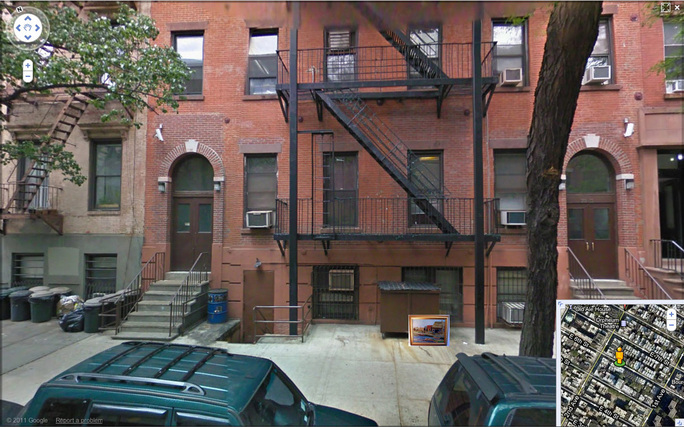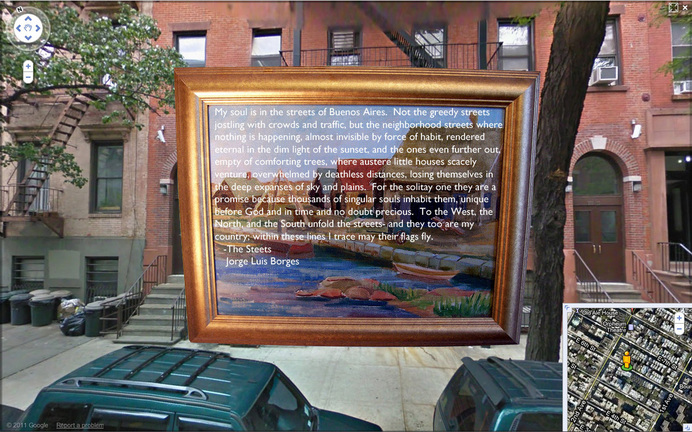F.Y.T. Co. and MUSEUM1
MUSEUM1 transforms space into place by designating public sites as part of an aesthetic institution. MUSEUM1 has three parts.
1. Labels. These markers tell you what objects and events have been entered into the museum. There will also be an online documentation where one can examine the exhibition as a broad geographic constellation.
2. 1 Place 2 Places. Found, second-hand paintings of landscapes over which a poem about a place is scrawled. These are dropped around the city as though they are trash and documented as part of the museum.
3. Red Dot. The indicating marker that YOU ARE HERE meets the ownership of an artwork. While an audience member occupies the space they own the view as though it had been purchased.
MUSEUM1 comes from the street tradition of putting a '1' after your name signifying that you are the 'one and only'. This bravado also has to do with the act of territory and a sense of permanence, however MUSEUM1 is not interested in longevity, only in redefinition and playing with the hierarchy of display.
F.Y.T. is looking to support many new and exciting projects in the upcoming year, one of the first being MUSEUM1 featured in New York City. MUSEUM1 is designing a transgressive museum structure: if aesthetic institutions provide context for objects by altering the means by which they are viewed, MUSEUM1 will set up a display that has never been attempted. Marking found objects in the city with labels, the first task of MUSEUM1 is archiving New York into its readymades including trash, people, and actions among other sculptures. The discarded and overlooked objects will be put into a context. Found thrift store paintings will spatially layer the audience's experience, crafting multiple subjective states and representational codes. The compiled descriptions create a psychological space placed inside the context of the city. Romantic recognition of different locales creates an exchange between artist and audience that acknowledges different views brought together by the happenstance discovery of the work by the audience. The artists perspective will slow down the pace of the visitor creating a personal relationship with the space to help them recognize the specificity of the place they are in. The last featured work is a series of red dots that indicate 'YOU ARE HERE' and that the place you are standing in belongs to you. It is as though you had purchased the view like a work of art.
1. Labels. These markers tell you what objects and events have been entered into the museum. There will also be an online documentation where one can examine the exhibition as a broad geographic constellation.
2. 1 Place 2 Places. Found, second-hand paintings of landscapes over which a poem about a place is scrawled. These are dropped around the city as though they are trash and documented as part of the museum.
3. Red Dot. The indicating marker that YOU ARE HERE meets the ownership of an artwork. While an audience member occupies the space they own the view as though it had been purchased.
MUSEUM1 comes from the street tradition of putting a '1' after your name signifying that you are the 'one and only'. This bravado also has to do with the act of territory and a sense of permanence, however MUSEUM1 is not interested in longevity, only in redefinition and playing with the hierarchy of display.
F.Y.T. is looking to support many new and exciting projects in the upcoming year, one of the first being MUSEUM1 featured in New York City. MUSEUM1 is designing a transgressive museum structure: if aesthetic institutions provide context for objects by altering the means by which they are viewed, MUSEUM1 will set up a display that has never been attempted. Marking found objects in the city with labels, the first task of MUSEUM1 is archiving New York into its readymades including trash, people, and actions among other sculptures. The discarded and overlooked objects will be put into a context. Found thrift store paintings will spatially layer the audience's experience, crafting multiple subjective states and representational codes. The compiled descriptions create a psychological space placed inside the context of the city. Romantic recognition of different locales creates an exchange between artist and audience that acknowledges different views brought together by the happenstance discovery of the work by the audience. The artists perspective will slow down the pace of the visitor creating a personal relationship with the space to help them recognize the specificity of the place they are in. The last featured work is a series of red dots that indicate 'YOU ARE HERE' and that the place you are standing in belongs to you. It is as though you had purchased the view like a work of art.


